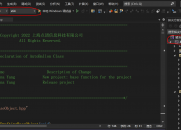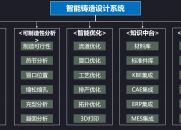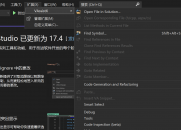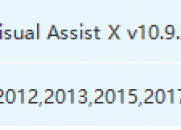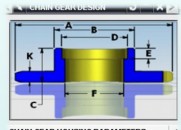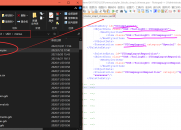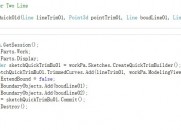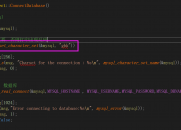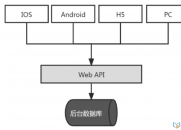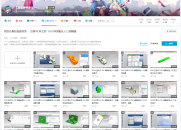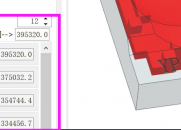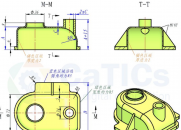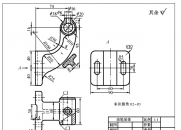|
|
请使用QQ关联注册PLM之家,学习更多关于内容,更多精彩原创视频供你学习!
您需要 登录 才可以下载或查看,没有账号?注册

x
9 ~3 u& ]- R2 a
7,裁剪片体
" s0 {, A: l) a2 i0 t2 htag_t *trim_objects;
9 K/ I; Z" `8 `; ~& `- Ttrim_objects =new tag_t[count];* L8 m- Q' o3 Y ^3 [% D9 c! R+ T
trim_objects =bound_id;5 A7 t- ^$ f. q( V' S, I
voidtrim_sheet()9 }4 n5 C! r" ]! n2 [4 L+ x- n; I( e/ E
{' V5 G- F# I$ x8 g
* A2 ]" @" m7 l5 q0 _# O UF_MODL_vector_t projection_method ;
8 ]( I/ L; q& [6 t) W; h% y% N projection_method.reverse_vector=0;
R9 x( O( e2 x* X projection_method.vector_type=UF_MODL_VECTOR_DIRECTION;5 n/ f8 q% F* O5 k
UF_MODL_vector_defined_by_union_tdir1;3 d2 _6 e& O+ o2 B/ ~$ B1 x
UF_MODL_vector_direction_t dir2;5 G0 P1 A1 N7 V/ O& n
dir2.xyz [0]=dir[0];
) a0 {! O% T0 }& k1 `. q$ X dir2.xyz [1]=dir[1];
3 A: X( W8 c5 {6 u5 e dir2.xyz [2]=dir[2];
2 P0 A- f1 @9 z- J dir1.direction=dir2;
% M7 @- W# d0 X0 [! x* g( [( i/ F' A- h% p) J# w& d
projection_method.defined_by=dir1;
& t7 g% b5 {2 E# j! q9 A3 ^! C2 X. B X3 S' I* r
double point_coords[3] ;
$ f0 S3 y, d. H% n$ I0 i- c$ M
point_coords[0]=center[0];
) H0 J s/ g- T point_coords[1]=center[1];9 j3 Q: h/ C, T% I. k9 R1 ?
point_coords[2]=center[2];6 P# h' z& A1 G# k1 u: p7 g
- ]0 \# i$ ^( G* \4 v0 P# w0 f int gap_point_count ;
' g5 i4 L. v- n1 S$ \( v) ? double *gap_points;
5 ?9 n. `( w. A tag_t feature_obj_eid;
* [/ X( X" [4 {' I2 d9 g8 j UF_MODL_create_trimmed_sheet(sel_sheet,edge_count,trim_objects,&projection_method,
) G# `8 g+ o$ u( U; B 0,1,point_coords,0.1,&gap_point_count,&gap_points,&feature_obj_eid);
. H0 \' H9 T2 W+ B4 W" G/ ?) J5 O0 O" f9 U6 x# k
}
9 S5 l' f5 y; G" e! T8,offset偏移. A1 s1 z e2 O6 |: E4 c
9 F7 q! ]$ k2 x/ W [- d
char distance_str[] = {"10.0"};//偏移的距离2 u. b3 c; [% a7 ~7 u5 a, ]
2 r3 h3 `, M6 D/ a* Wint num_curves;# ]- p9 [5 c, i% r9 M, w* v: X
tag_t *offset_curves;
6 p# o' g% _2 _: i3 n4 K* zUF_CURVE_offset_distance_data_t offset_distance;2 u! O% o: X H* n+ e/ x; S
offset_distance.distance= distance_str;& K, S9 V f0 ?' w# |) q
offset_distance.roUGh_type=1;
2 d0 F% u5 e0 t% sUF_STRING_t input_string;
& ~2 _. a8 \+ @" `& p/ W; x* X( ainput_string.id=curve_id;//加入想要偏移的线
0 W% R: V9 `" d0 Einput_string.num=1; //偏移矢量方向数量9 W0 I( ?5 {- k5 Q& Q
input_string.string=&string_count;//偏移线的数量7 Z$ m" U( K9 B
intstring_dir=UF_MODL_CURVE_START_FROM_END;
! f; i' X. W. C0 rinput_string.dir=&string_dir;# e, U# L2 B; U* h: `6 t- ?( _
5 I! W- m( u) l5 Y B% }8 r3 JUF_CURVE_offset_data_toffset_data;% y+ j( R+ V g" \; E& W+ d. c
$ w# ~8 c9 g3 N
offset_data.offset_def.distance_type1= &offset_distance;) d% a4 R' U1 |& p1 u
offset_data.input_curves= &input_string;: s! m0 u: w( B B
offset_data.approximation_tolerance= 0.01;
0 z7 U8 O8 W4 w5 x) Voffset_data.string_tolerance=0.001;
" @" m3 w( t! h" G1 ~3 o& ~. Soffset_data.offset_def.distance_type1= &offset_distance;
9 [7 ^5 R% t/ R% ~7 B1 V6 V' U* k; c: moffset_data.offset_type= UF_CURVE_OFFSET_DISTANCE_TANGENT;
- [& `5 x4 Q) [& H4 }: w* @ bUF_CALL(UF_CURVE_create_offset_curve(&offset_data,7 l& k6 y( {9 n3 z% b' e
&num_curves,&offset_curves));
: Q% m) U7 P) Q1 X) l9,创建平面/ S% w1 Z. P4 m, c+ N
UF_STRING_tgenerator;
% @" G0 h/ ^; m$ P5 @# XUF_STRING_p_tge = &generator;! p- F; \% d5 F. p
' J- W5 \* y' e+ T. aUF_MODL_init_string_list(ge);0 E/ s, H3 n: B1 p& S
UF_MODL_create_string_list(1,12,ge);
' z- H0 I" S( p. R f% C0 ~/ V& C* `+ T, O7 [8 |! y
ge->string[0]= 1;
* b0 J; X& E. @ge->dir[0]= 1;//指定线从开始到结束
: Z( i# ^) c( e" nge->id[0]= arc_id;//指定边界的id6 D8 i0 g6 A( v5 G. E" J
doubletol[3];. A$ Y/ _( J" P
tol[0] =.001;//直线公差
- D0 B, {" T+ R* K# ?7 ~" C( I( Rtol[1] = .5* (PI/180);//圆弧公差* E% W8 U! Y/ Y+ V" v
tol[2] =.02;//不起作用( r. f4 b1 ?" v( @3 m
UF_CALL(UF_MODL_create_bplane(ge,tol,&bplane));
0 x ?, E* P; O- D( ? C10,选择
. s/ _9 ?. [# z# x) E" E1),点选择! X$ k! P F# k% b( L
tag_t point_tag;6 w! W5 t0 N& z3 H% C. t
double point[3];
. o8 y6 |% c7 ]6 u, A) h2 n UF_UI_POINT_base_method_t base_method=UF_UI_POINT_INFERRED ;
' k+ ? R g1 c. u6 O) k& g5 b: ? intpoint_res;
0 U$ n3 T( Y- i1 A' |& f( d/ L; i+ ]$ l9 d
UF_CALL(UF_UI_point_construct("选择起点",&base_method,&point_tag,3 D2 ]8 u% B, u/ C
point,&point_res));
, S' `- g* y+ b5 C3 ^if(point_res=UF_UI_OK&&NULL_TAG!=point_tag)5 r2 P+ I1 S' l2 e9 i) X4 t
{
: U. C {1 P) J! s }, {( G3 C% S( T* P) L; l$ a- w$ x
2),向量选择
0 c6 f/ n% d: f9 p3 P int mode = UF_UI_INFERRED ; T7 b {0 f7 t3 }* E9 {9 ?
int disp_flag = UF_UI_DISP_TEMP_VECTOR;7 ^9 @# X1 @9 @8 e. U, G
double vec[3];
# \: e8 m9 O9 t+ c5 fdouble vec_pnt[3];0 c- ?. R' n* F, M
int res_vec = 0;1 d0 R6 E. p* i
UF_initialize();
% g0 o# z& g" U. x X$ v+ J ifail= UF_UI_specify_vector( "Choose aVector",&mode,disp_flag,
1 |& H3 t/ T9 o0 p vec,vec_pnt,&res_vec);! ?2 U6 r0 \: E1 }( a: }
if( ifail != 0 || res_vec!= UF_UI_OK ) ' J) T# i, N }7 E; i
{
& \0 |/ G: E4 F$ s UF_UI_ONT_refresh();
6 E& m7 }3 i, W- H) S; n printf("No vector selected \n" );
7 k# j+ v; L5 H) v5 I }" I9 s- Q# A( E6 L+ X3 z
else
; `2 v. X! J b# k {
/ j- [# C1 ?2 w- B' S5 O0 r2 _ printf("Vect base (%f, %f, %f), direction (%f, %f, %f) \n",- a# }* G# b) R
vec_pnt[0],vec_pnt[1], vec_pnt[2], vec[0], vec[1], vec[2] );
0 F$ ^( i! W- D" R2 E5 N}; y, M3 @3 M6 K1 v1 q2 z) l% E
3),平面选择
( g$ s3 S# J) h) ktag_t plane_eid=NULL_TAG;( P( Z+ q, o4 N! l; Z
double orientation[9] ={0,0,0,0,0,0,0,0,0};
3 J) e6 b/ D+ L: y double origin[3] = {0,0,0};1 U" C6 h" ^- ]$ N6 s0 J( Z" [+ c
double pts[6] = {0,0,0,0,0,0};
; C# Y! e& _; M int i, error_code = 0;4 T' B2 s1 n! }; G, f
int mode, display, response;, N9 ?, G) L% g% b6 L$ Z
mode = 1; . z- i% d6 C& `7 @+ x a
display = 0; * N: }* r: S- F5 K
UF_initialize();
$ p; g; V7 v3 n. t |' w0 T# L error_code = UF_UI_specify_plane(
1 {7 ]. c3 H6 V' ^* U+ M "Select Plane", &mode, display,4 d- y$ u* H5 T: }0 w, L# D
&response, orientation, origin,&plane_eid);, {: W4 c- [, r1 x
& v, ]2 q9 k3 `$ F
if ( !error_code && response != 1&& response != 2)1 h0 g' a% F6 {% i
{
+ x3 O. `, f7 d: T* D for (i=0; i<3; i++)
0 D6 e" F! B0 _0 @4 C pts = origin + orientation;
" {' N& s8 {2 S4 @6 i0 H for (i=3; i<6; i++)' Q9 v% f6 O+ V$ [( \, R6 K
pts = origin[i-3] + orientation;! x& t+ j1 t9 w- ?0 i9 f- i, k' w1 K- s
FTN(uf5374)(origin,pts,&pts[3],&plane_eid);
: q# c: |5 r9 m9 I0 x }5 P1 M, j" W( m E% [: D
11,临时点,线
4 Y/ X6 P6 `* I+ l. G* y/ A( cvoid display_temporary_point_line (double point1[3], double point2[3]), w% _ I7 `- u5 z! p) C
{9 c& s6 T0 M/ x! V
UF_DISP_view_type_twhich_views = UF_DISP_USE_WORK_VIEW;+ C* z) n- h5 P& [, ]8 W2 P
UF_OBJ_disp_props_TColor;$ Y1 S: W0 M* _, d; y+ [
color.layer= 201;
! t' \, r9 l$ r+ \ color.color= 186;. _/ Z! m- @( C8 U) b
color.blank_status= UF_OBJ_NOT_BLANKED;
! b9 E. ?2 R5 X9 Y color.line_width= UF_OBJ_WIDTH_NORMAL;4 w. l5 s* V5 ^% D1 R
color.font=0;9 W% g$ K- N! H8 f, d; v
color.highlight_status= FALSE;- w9 ^5 g j5 ?! }" T3 I
UF_DISP_poly_marker_tmarker_type = UF_DISP_POINT;
/ F9 p- {# V ]1 x9 y/ N7 @
0 V) o! d2 y% tUF_DISP_display_temporary_point ( NULL,which_views, point1, &color, marker_type);1 s( }6 q% R. p( A
UF_DISP_display_temporary_point ( NULL,which_views, point2, &color, marker_type);3 T# e/ X6 D% _& f
UF_DISP_display_temporary_line ( NULL,which_views, point1, point2, &color);
, Q% A) H T3 @6 G# O}
: M5 N( U w' H/ C$ m+ b12,WCS与绝对坐标转换& k" M' B# V! R9 [# q) [
voidcycs_wcs(double point[])% ^ @" w* X# [3 z
{
7 d4 p! ^9 F. E3 U# ? tag_t wcs_id,matrix_id;) }# _* t2 F/ |% t, L) k. ~, S5 w
double matrix[ 9 ];
5 u- z6 w% s* b. | //wcs_origin:工作坐标系原点,vec:工作坐标系轴向量,point_origin:点到原点的矢量8 v }* A3 o3 v; @* R. V
double wcs_origin [3],vec[3][3],point_origin[3]; ? b& P* I1 N; R/ }9 e
//1,得到工作坐标系
# t( O, i {, `% X UF_CSYS_ask_wcs(&wcs_id);: _0 H: g7 h9 N/ K c/ |* o9 q a
UF_CSYS_ask_csys_info(wcs_id,&matrix_id,wcs_origin); 7 P6 y/ n* Y, z5 z* Q- S. C$ I L
UF_CSYS_ask_matrix_values(matrix_id,matrix);
7 o) s: ^* d0 I9 ~& k1 R$ f- t$ S
! _: t/ Y Q+ x. g# ] //2,得到工作坐标系轴向量# g% n7 }( o- ^5 l. E, X
UF_MTX3_x_vec (matrix,vec[0]);" p4 W! Z8 M; m! @" x. A
UF_MTX3_y_vec (matrix,vec[1]);4 ?- j$ h- {9 @! h1 k& ^: d
UF_MTX3_z_vec (matrix,vec[2]);
/ L$ }* C1 w; r) |4 e. ]
5 f. O1 F" v3 n- L, ]. Y* s9 Y for(int i=0;i<3;i++). h! e: Z1 a9 F. r6 C
{ " @" k" V* R5 B7 Y4 P; k. i
double tol;
) {; E* T) |( R2 L8 H: e' Q//3,得到点到工作坐标系原点矢量) [! D( k# \+ [- q2 P# v0 Q
UF_VEC3_unitize(vec,0.000001,&tol,vec);
8 Z% k0 l% x s0 `7 z//4,得到点到工作坐标系原点矢量
4 |: c3 `) Q8 T point_origin=point-wcs_origin;' p4 R9 J1 S- G6 w8 ^- k* k
}
% k7 d# x# F% X8 L& E for(int j=0;j<3;j++)' z" M# `: E3 X) n" K6 I4 x9 D+ I0 _
{7 q u( m4 J! l- l
UF_VEC3_dot(point_origin,vec[j],&point[j]);: s; U, f) W3 x. z. q; E. F
}) H4 C0 w7 N+ d2 |/ E# |% A ^
}
$ W* A }) o* b+ F13,三点求圆心
; L4 P9 i# ^7 S' e#include<iostream.h>
! w0 \& W2 o& J( E" T! [- L7 f#include<math.h> ! a6 L1 Z$ U8 Z
4 b7 Z2 O$ c/ H+ iint main()( F f! v9 J0 S8 D$ m
{* S, w; E! F% f" o, c* R
int x1,y1,x3,y3;" K5 d% k; u4 S5 B; q! e2 v; Q
double a,b,c,d,e,f;' X1 u1 k( C- c5 d: E, Y5 }
doubler,k1,k2,x,y,x2,y2;
& X+ r! ?+ M# ^8 K \ cout<<"请输入x1,y1,x2,y2,x3,y3"<<endl;7 Y# H3 Q3 a ?- T# E/ \! O; t
cin>>x1>>y1>>x2>>y2>>x3>>y3;# Q5 \- {5 a* L; S; y4 r
if((y1==y2)&&(y2==y3)) W' m+ j- E5 R7 b0 r
{6 x; u, g% c' a- Q# y) [# j1 U
cout<<"三点不构成圆!"<<endl;. ~$ }2 H2 f5 }; i, S9 b' N
return 0;4 ^6 Q# C# ]2 u, Z( ]3 W, E' ?
}9 L/ ] ]" A: q0 a
if((y1!=y2)&&(y2!=y3))- {: U: B) ^; w0 r3 W
{. o* t9 C) ^+ M
k1=(x2-x1)/(y2-y1);
" H \2 Y7 y1 J8 R k2=(x3-x2)/(y3-y2);) @6 X# N1 @$ ?. y
}% k' [8 v, g: y9 s2 d5 [
if(k1==k2)( y" \/ |1 c* I. z
{: Z S* t% l, t5 D+ V6 b M) [$ x
cout<<"三点不构成圆!"<<endl;. J* {2 B& X& X& O' C E2 s
return 0;
6 w: F4 m; S. R5 x" E }
" M, D1 P7 m' o& U* J+ q a=2*(x2-x1);" d$ L% k3 y$ X" X* q1 v" ]
b=2*(y2-y1);! `, | |7 ~ @9 x2 S
c=x2*x2+y2*y2-x1*x1-y1*y1;: B& ?, \/ f( o& v4 r' G
d=2*(x3-x2);9 w4 G5 ] L, l7 i5 \& B3 N
e=2*(y3-y2);
* W' n. v, u+ Z) U6 { f=x3*x3+y3*y3-x2*x2-y2*y2;
, ~9 u/ p0 r$ I" B' b5 O x=(b*f-e*c)/(b*d-e*a);* Z) S0 l3 B. c; y _4 n
y=(d*c-a*f)/(b*d-e*a);& B5 H4 C- y$ G2 w4 ?& D2 f
cout<<"圆心为("<<x<<","<<y<<")"<<endl;
4 p$ ?/ w& f. q; I r=sqrt((x-x1)*(x-x1)+(y-y1)*(y-y1));
9 j+ P4 e+ l+ r& a6 b x- H$ ^ cout<<"半径为"<<r<<endl;
+ {, I; [0 i& X$ f+ m8 n. e9 _+ k9 f return 0;
# T9 N( ~* g- |! `: Q) r& o}6 c* l' _9 F9 u8 i
14,查找圆心3 a- d" X; s9 E' T( V
UF_EVAL_p_tevaluator ;
' J2 _2 D/ K9 W UF_EVAL_arc_t arc;
! m$ q) ^/ d2 v) o% ^2 V# y UF_EVAL_initialize(obj_tag,&evaluator);! n0 j6 B% q& x0 L( u' [5 M
UF_EVAL_ask_arc(evaluator,&arc);" g7 H; x. w6 E: `
UF_VEC3_copy(arc.center,point);
% D' J3 m: O% \' x) q15, message_box4 s* ~. h/ Z6 \+ S
void message_box(int *res_mes) a) E, |& q! o3 t, S
{
: E* G' [9 p0 E; F3 i# ^ UF_UI_message_buttons_sbuttons;
3 Z5 X: ?5 ^5 ^0 ` buttons.button1=TRUE;
& a. K+ A# n# C8 K7 ]7 Z( ~ buttons.button2=FALSE;8 Z- y: I! C, @+ V
buttons.button3=TRUE;
! {! b) S1 [! o! R" \# T7 t) Q* G$ [
buttons.label1="OK";5 B y0 `0 C+ _+ I2 O
buttons.label3="CANEL";( ~* c! W9 y; y0 x' E6 m0 f
% {* |- N7 L8 C& L! j9 n buttons.response1=UF_UI_OK;
3 J( ]' g+ y# L6 m4 `" l buttons.response3=UF_UI_CANCEL;
8 C* S7 l% j1 o7 u. Y- i$ n7 N' m! I. o1 Q8 W2 {2 b
char *string_msg;
8 J% S: R( }+ M O5 G6 q6 ] [ char*material_msg="ALL selcted objects will be removed";
9 ^6 F; {9 W' `# S" k( A string_msg =material_msg;
( o8 M1 } ]! s6 b, m6 O( r& ~# A F2 [9 Y4 R
UF_CALL(UF_UI_message_dialog("",+ m: g. C* y* C: Y) e
UF_UI_MESSAGE_WARNING,
6 y2 B4 p2 d/ M' {4 }( ] &material_msg,; A: g' S) w. a' I2 O1 V
1,& N9 T( @* m7 e9 P, d& T
TRUE,/ Z, h& ]0 q- U
&buttons,
; h* G* H0 v# d5 I res_mes ));
4 J3 {5 X! _; r- j}
z& H" H& j/ `5 b+ x8 L16,选择过滤5 y* u M0 x- R7 ]( @- l4 I( v
static int init_add_face( UF_UI_selection_p_t select, void *client_data)8 _: N+ R# Y* s9 l) b; \
{ @" \/ E$ T, {8 g# U
int nums = 1;
4 d7 ]) X% J, K7 P& {* _& C& y UF_UI_mask_t masks[] ={2 I/ z( T" w3 G5 o% J1 Y/ Y% f9 A& l
UF_solid_type, 0,UF_UI_SEL_FEATURE_ANY_FACE};% U/ E0 N1 T `+ P5 k/ X5 |/ W
: |1 X( A' e- B5 T) p7 n( x# x. G; x
if(
( y. F8 f; o0 C4 w$ `/ u# i Q (UF_UI_set_sel_mask(select,UF_UI_SEL_MASK_CLEAR_AND_ENABLE_SPECIFIC,nums,masks)==0)0 {" |8 y' e7 S. r9 f) o$ o
&&(UF_UI_set_sel_procs(select,filter_proc_circle,NULL,client_data)==0)" A. w/ T6 ^ D, x. k, q
)
0 a& g5 q2 }, N) i @ {7 K' a3 L6 x0 N6 d0 p
return(UF_UI_SEL_SUCCESS);
( ^, N) E9 L1 V5 L& K& O }
% a0 C- s! ]0 W else/ u0 \, e, O9 t/ [
{ * s! s) I. w) g& Z: ^
return(UF_UI_SEL_FAILURE);4 K. n" ~! h7 `* ^+ @6 j
}
/ p( e7 l$ U G- A5 c* s1 H}) q; `8 G) @6 X5 [
int find_tag(+ ~+ w0 h4 c, P( ^) @5 r
void * client_data,//用以传输过滤资料1 T- M2 R9 b9 }& I, Z
tag_t object//现在鼠标所选物体ID
2 y( d' F& \) G$ h8 j. S; J1 R )" z" r# Z ?' Q0 }; P. q W' }
{
; l' }$ y1 j: T7 Z user_data *obj;. |4 ]+ E- l+ R3 H; M, J6 g) F
obj=(user_data*)client_data;
7 s2 ^8 r& V' H5 l int find_face=true;//接受' }1 r2 w( C2 E, \
char *string1;4 ] X7 ]6 t) \" ]$ M: p0 [
string1=newchar[133];. D6 [3 m$ u5 l1 F; R W
string1=UF_TAG_ask_handle_of_tag(object);, l5 @9 V4 j* S; H4 [0 o2 U
for(int i=0;i<过滤的数目;i++)
" r# H6 z5 l" X0 [" J7 J {2 u% M! l2 @( \/ c1 a) h5 w" @
# E/ B3 y2 N7 v: I5 g
char *string2;
- J8 {' z- N- @0 F: v( D string2=newchar[133];
y4 ^ w% u# d& p$ W1 i. x string2=UF_TAG_ask_handle_of_tag(物体ID);
0 F# Q& Z& i; ^5 S+ {( v; V8 a$ z if(strcmp(string1,string2)==0)
. ]0 ~' l+ s3 F; [% z9 k3 a {# m' i! W" k7 V9 S
find_face=FALSE;//不接受" |" g8 e* F# }( e! Q
7 |% o& b. }- x. Z- Q8 @ }3 q8 p: }3 r& M5 t
delete []string2;) S3 o1 o1 `1 A; W+ L
}% ~" [ v, a! X: q% n
delete []string1;" {: p% C- N, D" ?0 U
return find_face;( z/ a- q& l: i [. y
}
/ J2 I5 x- s" ?1 B4 {
, E8 g9 [ v, r/ h m, T0 W |
|


